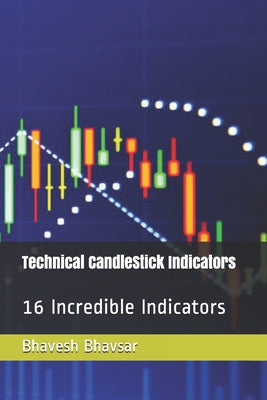
Business & Economics
Technical CandleStick Indicators: 16 Incredible Indicators
Technical CandleStick Indicators: 16 Incredible Indicators
INDEPENDENTLY PUBLISHED
Select Format
Regular price
$8.08 USD
Regular price
$5.31 USD
Sale price
$8.08 USD
Unit price
per

Types of Technical Indicators 1. Trend Indicators: Identify the direction and strength of a trend.
1. Moving Averages (MA): Calculate the average price over a specified period.
2. Relative Strength Index (RSI): Measures the magnitude of recent price changes.
3. Bollinger Bands: Plot volatility and provide a visual gauge of price action.
2. Momentum Indicators: Measure the speed and change of price movements.
1. Stochastic Oscillator: Compares the closing price to its price range over a given period.
2. MACD (Moving Average Convergence Divergence): Plots the difference between two moving averages.
3. Rate of Change (ROC): Measures the percentage change in price over a specified period.
3. Volatility Indicators: Measure the magnitude of price fluctuations.
1. Average True Range (ATR): Calculates the average range of price movement.
2. Bollinger Bands: Also used to measure volatility.
4. Volume Indicators: Analyze trading volume and its impact on price movements.
1. On Balance Volume (OBV): Measures buying and selling pressure based on volume. How to Use Technical Indicators 1. Combine Indicators: Use multiple indicators to confirm trading signals and reduce false alarms.
2. Set Parameters: Adjust indicator settings to suit your trading strategy and time frame.
3. Monitor and Adjust: Continuously monitor indicator performance and adjust your strategy as needed.
4. Backtest and Validate: Test indicators on historical data to validate their effectiveness. Limitations of Technical Indicators 1. Not Foolproof: Indicators can produce false signals or fail to predict market movements.
2. Lagging Indicators: Many indicators are based on historical data and may not respond immediately to market changes.
3. Overreliance: Relying too heavily on indicators can lead to neglect of other important market factors. Best Practices for Using Technical Indicators 1. Keep it Simple: Avoid using too many indicators, which can lead to analysis paralysis.
2. Understand the Indicator: Know the strengths, weaknesses, and limitations of each indicator.
3. Use Multiple Time Frames: Analyze indicators across different time frames to gain a more comprehensive view of the market.
4. Combine with Fundamental Analysis: Use technical indicators in conjunction with fundamental analysis to form a more complete view of the market.
1. Moving Averages (MA): Calculate the average price over a specified period.
2. Relative Strength Index (RSI): Measures the magnitude of recent price changes.
3. Bollinger Bands: Plot volatility and provide a visual gauge of price action.
2. Momentum Indicators: Measure the speed and change of price movements.
1. Stochastic Oscillator: Compares the closing price to its price range over a given period.
2. MACD (Moving Average Convergence Divergence): Plots the difference between two moving averages.
3. Rate of Change (ROC): Measures the percentage change in price over a specified period.
3. Volatility Indicators: Measure the magnitude of price fluctuations.
1. Average True Range (ATR): Calculates the average range of price movement.
2. Bollinger Bands: Also used to measure volatility.
4. Volume Indicators: Analyze trading volume and its impact on price movements.
1. On Balance Volume (OBV): Measures buying and selling pressure based on volume. How to Use Technical Indicators 1. Combine Indicators: Use multiple indicators to confirm trading signals and reduce false alarms.
2. Set Parameters: Adjust indicator settings to suit your trading strategy and time frame.
3. Monitor and Adjust: Continuously monitor indicator performance and adjust your strategy as needed.
4. Backtest and Validate: Test indicators on historical data to validate their effectiveness. Limitations of Technical Indicators 1. Not Foolproof: Indicators can produce false signals or fail to predict market movements.
2. Lagging Indicators: Many indicators are based on historical data and may not respond immediately to market changes.
3. Overreliance: Relying too heavily on indicators can lead to neglect of other important market factors. Best Practices for Using Technical Indicators 1. Keep it Simple: Avoid using too many indicators, which can lead to analysis paralysis.
2. Understand the Indicator: Know the strengths, weaknesses, and limitations of each indicator.
3. Use Multiple Time Frames: Analyze indicators across different time frames to gain a more comprehensive view of the market.
4. Combine with Fundamental Analysis: Use technical indicators in conjunction with fundamental analysis to form a more complete view of the market.
Large Print:
Yes
Large Print:
Yes
Language:
English
Language:
English
Release Date:
October 2010
Release Date:
October 2010
Length:
263 Pages
Length:
263 Pages
Weight:
0.66 lbs.
User reviews will be displayed here...
Related products or products you might find interesting

40% OFF

25% OFF

25% OFF

40% OFF

40% OFF

40% OFF

40% OFF

40% OFF

36% OFF

Business / Economics / Finance


